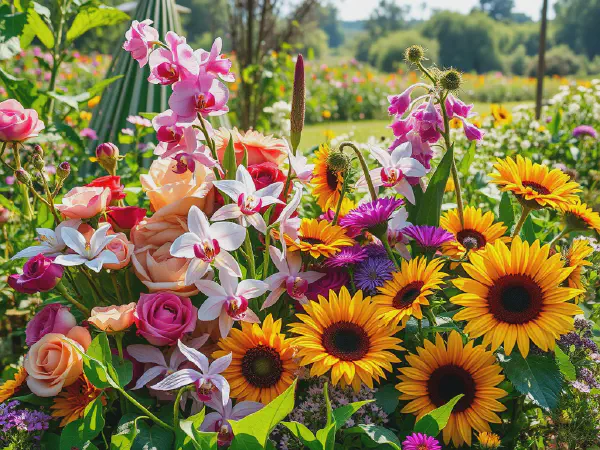Exploring Types of Flowers: Discover Floral Diversity

Exploring the Diverse Types of Flowers
Flowers are one of nature’s most beautiful creations, showcasing a wide variety of shapes, colors, and scents. They play a crucial role in many ecosystems and have significant cultural, aesthetic, and nutritional value. Understanding the types of flowers can deepen our appreciation for their beauty and importance.
Among the different types of flowers, some can be categorized based on their ecological role, ornamental value, or edibility. Wildflowers, for instance, grow naturally without human intervention and play an essential role in habitat provision. Ornamental flowers, on the other hand, are cultivated for visual appeal in gardens and floral arrangements. Edible flowers are gaining popularity for their unique flavors in culinary applications.
In addition to these categories, flowering plants vary by region, exhibiting unique adaptations to their specific climates and environments. Seasonal flowers also highlight the diversity of blooms available throughout the year. This article will explore various types of flowers, emphasizing their characteristics, uses, and regional distinctions, to offer a comprehensive understanding of this fascinating topic.
Ultimately, the types of flowers encompass not only those commonly found in gardens but also the myriad of wildflowers, edible varieties, and seasonal blooms, which contribute to our world in profound ways. From enhancing the beauty of landscapes to providing sustenance, flowers hold an essential place in our lives.
As we explore further, we will delve into distinct categories of flowers, including wildflowers, ornamental flowers, edible flowers, and the varying flowering plants across different regions, along with the seasonal offerings in gardening and nature.
Wildflowers
Wildflowers are plants that grow naturally in the wild, without intentional cultivation by humans. They are typically found in meadows, fields, and forests, showcasing a stunning array of colors and forms. Their characteristics often include hardiness to environmental changes and the ability to thrive in diverse conditions, making them crucial for local ecosystems.
Some popular wildflower species include the California poppy, bluebell, and coneflower. These flowers are not only beautiful but also attract pollinators like bees and butterflies, contributing to biodiversity and ecological health.
Ecologically, wildflowers play a vital role in supporting various life forms. They provide forage for pollinators, serve as habitats for insects, and help to prevent soil erosion, promoting a stable ecosystem where many species can coexist.
Ornamental Flowers
Ornamental flowers are cultivated primarily for their aesthetic appeal. Popular types include roses, tulips, and daisies, which are widely used in landscaping and decorative arrangements. These flowers can vary significantly in their colors, sizes, and shapes, tailored to enhance gardens and public spaces.
When choosing ornamental flowers for gardens, consider factors such as climate, soil type, and the intended aesthetic. It is essential to select flowers that will thrive in your region’s conditions and complement other plants in the garden design.
Maintenance tips for ornamental flowers include regular watering, deadheading to promote new blooms, and protective measures against pests and diseases. Understanding the specific needs of each flower will help maintain a vibrant, flourishing garden throughout the season.
Edible Flowers
Edible flowers are becoming increasingly popular in culinary circles, adding color and flavor to dishes. Common types include nasturtiums, pansies, and violets. These flowers can enhance salads, desserts, and beverages with their unique tastes and visual appeal.
Nutritionally, edible flowers can provide various health benefits. Many are rich in antioxidants, vitamins, and minerals, contributing to a balanced diet while also introducing exciting new flavors.
Culinary uses for edible flowers range from garnishing plates to being incorporated into sugary treats and salads. Their vibrant colors can transform dishes, making food more visually appealing and enjoyable.
Flowering Plants by Region
Flowering plants vary significantly based on regional characteristics. For instance, desert regions may showcase cacti flowers, while temperate areas may feature a wider array of blooming species, from magnolias to lilacs. Each geographical region nurtures its distinct flora, often leading to specific flower types that thrive in those locales.
Regional conservation efforts for flowering plants are critical. Preserving native species helps maintain ecological balance and protect biodiversity, ensuring that unique flowers associated with specific regions continue to flourish, benefiting both the environment and local culture.
Climate plays a significant role in determining flower types. Factors such as temperature, precipitation, and soil quality influence which plants can thrive. Understanding these factors can aid in selecting appropriate flowers for garden planting and conservation efforts.
Seasonal Flowers
Different types of flowers bloom throughout the year, with spring flowers like daffodils and hyacinths heralding the new season. These early bloomers often symbolize renewal and are favorites among gardeners eager to see color return to their landscapes.
Summer flowering plants are abundant and can include sunflowers, zinnias, and lilies, which add a vibrant palette to gardens and outdoor spaces during the warm months. Their thriving presence contributes to the atmosphere of summer festivities.
During fall and winter, flower varieties such as chrysanthemums and hellebores showcase their beauty even as temperatures drop. These seasonal flowers offer beauty and charm when many other plants have faded, providing interest and color in the cooler months.
